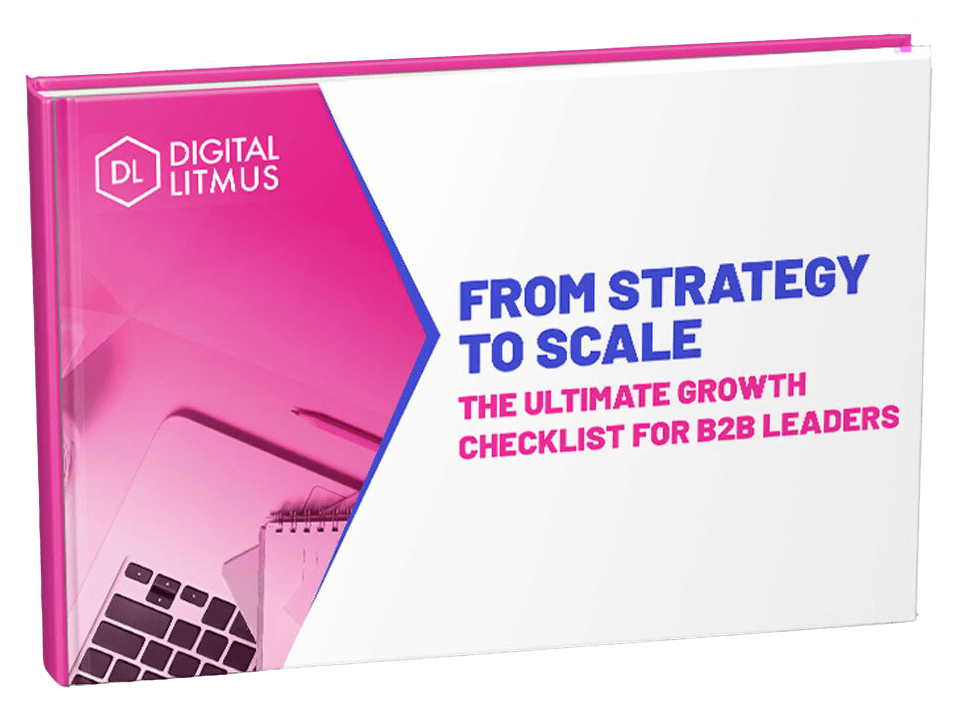Unlike outbound methods like cold calling, inbound marketing attracts customers through interesting and valuable content that you publish online. It's all about building digital assets that do the work for you 24/7.
75% of global companies invest in some form of inbound marketing – it's perfect for SaaS businesses, consultancies, and any other type of company that has an online presence.
When B2B companies invest in inbound marketing, they usually see a significant increase in website traffic, leads, and sales.
In this article, we will explain what B2B inbound marketing is, and how B2B companies can get the best out of their investment in it. We'll also explore five powerful inbound marketing tactics that are making the most impact for B2B businesses today.
What is B2B Inbound Marketing?
B2B inbound marketing is the process of creating and distributing content and services that attract, engage, and convert B2B buyers. Its goal is to provide potential customers with enjoyable, valuable information that can help them at each stage of their buyer’s journey. It contrasts with outbound marketing, which is the process of reaching out to potential customers with marketing messages in the hopes of generating leads and sales.
Inbound marketing is similar to content marketing, but with some crucial differences. You can think of content marketing as a subdivision of inbound; inbound marketing is a bigger-picture discipline that includes content as well as other marketing activities.
So for example, a content campaign might include blog articles, social media posts, and videos. But a wider inbound marketing strategy could also involve a free interactive tool on your website, an affiliate referral scheme, a PR campaign, and so on.
These activities can work hand-in-hand with content marketing, but wouldn't necessarily be designed or planned by a content marketer.
The phrase inbound marketing was initially made popular by HubSpot, the marketing and CRM platform, back in the mid-2000s. It has evolved from the idea of publishing as much general content as possible to offering much more personalised, well-segmented content for each buyer type.
Why Should B2B Companies Invest in Inbound Marketing?
Almost all B2B companies have the potential to develop an inbound marketing strategy. If you've got expertise within your organisation, it can be packaged and published in a way that will elevate your business performance.
Here are some of the ways inbound marketing can make a difference to B2B businesses:
- It converts visitors to sales. By sharing your expertise and offer in detail, visitors have a better understanding of what you can do to help them.
- It's cost-effective. Inbound leads cost 61% less than outbound leads, which are a lot more labour-intensive.
- It builds trust and credibility. B2B buyers are looking for thought leaders who can help them navigate their specific challenges. Inbound marketing helps B2B companies become a preferred information source for their buyers.
- It brings in higher-quality leads for your sales team, as they'll be further along the awareness funnel.
- It can lead to better conversations between you and your customers, as they're not in a pressured environment of a sales call. Instead, they'll reach out to you voluntarily.
Don't let your competition steal the show. Find out more about how you can start your journey towards a successful Inbound Marketing strategy with us!
Five B2B Inbound Marketing You Can Action Now
The world of inbound marketing never stands still. While the overall principles remain constant – publish useful, enjoyable content tailored to your target audience – you do have to be careful to choose what's working at the moment and what isn't.
That said, here are some of our favourite tactics that are delivering results right now.
1. Short-form LinkedIn Thought Leadership Videos
LinkedIn is one of the most effective channels for B2B growth.
The platform is great for growing your network, personal brand-building, and generating demand for the work you do.
On LinkedIn, videos you make will show up in the feeds of those connected to you based on what the algorithm deems interesting. So it's important to:
- Keep videos 1-3 minutes long
- Have a primary opinion, fact, or tip to share
- Get to the point and don't ramble
You shouldn't be short on ideas on what to talk about - consider answering frequent questions you encounter, addressing common pain points your customers have, or sharing opinions about the state of your industry.
You might find ideas start flowing once you've started, so you could batch produce a few at a time and release them daily or a couple times per week.
As people engage with each video, they'll be shown in more of your connections' feeds. People will become fans of your content if it's enjoyable and helpful - but you have to post on a consistent schedule if you want to make a real impact.
Thankfully, these videos are easy enough to make.
The production quality of your videos doesn't need to be outstanding. In fact, a more down-to-earth approach can make what you're saying more authentic.
Talking directly to your smartphone is one approach; just make sure you hold it still and the main source of light isn't behind you. While speaking to a computer webcam can be fine, it can also look like you're on a Zoom call, which isn't too inspiring. Instead, you can use software like Camo Studio to use your phone's main camera from your computer, making use of its superior lens for higher quality.
2. Ungated Long-form, High-value Content
Long-form articles are one of the most useful things you can provide.
By 'high-value' we mean articles that aren't just an interesting read. They'll genuinely educate or inspire people in the B2B space; they'll bookmark your content and return to it, and share it with their professional network.
'Gated' content is that which needs something in exchange for access – usually an email address or other contact details. But publishing to the open web is one of the core principles of inbound marketing, and it's a powerful way to attract and engage new visitors.
Ungated content can be indexed by search engines, which means it can bring in a lot more visitors to your site. It can still work as lead gen content, of course – you can add a paragraph containing a CTA to your services, or a form to sign up for email updates. It's all about bringing in new visitors and moving them through the funnel.
A typical high-value long-form piece needs to have:
- Solid structure and navigation
- Simple, understandable writing
- Images or features to break up the text
- Answers to questions your audience cares about
- Good SEO optimisation
Sometimes this means you'll have to invest more resources in content (compared to churning out low-effort blog posts 'just because'), but a single high-value post can be responsible for tens of thousands of pounds worth of traffic and leads. You pay for it once, but it works 24 hours a day, for months and years after you publish.
3. Video Nurture Sequences
Video nurture sequences are a great way to keep your leads warm, and can be used at any stage of the funnel.
The concept is simple: you produce a series of short (~90-second) videos, each one delivered to the viewer after they've taken a certain action. For example, someone might watch the first video in your sequence after subscribing to your newsletter. The next video might be delivered a few days later, and so on.
Each video should build on the last, providing more information or value, until eventually, you make an offer – whether that's a discount, free trial, or consultation call.
This is an extremely effective way to nurture leads without being overly 'sales-y'. You're providing value at every step, and only making an offer when the time is right.
To make this work, you need to have a clear idea of what your offer looks like, and what kind of journey you want people to take. Once you have that mapped out, producing the videos themselves is relatively straightforward.
Just like with LinkedIn video posts, you don't need to spend a fortune on production. That said, making the information easier to consume is always welcome – text transcriptions and subtitles are especially useful. Many video platforms have automatic tools for these built-in.
4. Bottom of the Funnel, High-intent, Keyword-focused Content
This is where you create the really good stuff, not top-of-the-funnel fluff content that appeals to 'everyone' but attracts no-one.
It starts with finding the bottom-of-the-funnel keywords for your proposition. These are the specific high-intent phrases that people search for when they want a certain problem solved, or want to learn about a niche topic that's highly relevant to them.
On the technical side, you can use keyword tools like SEMRush or Keywords Everywhere. These are a great starting point and should be used as part of any content strategy. But you're also going to have to use some old-fashioned human research skills.
How do your prospective customers actually talk about their problems? Do they know the name of the solution you're providing? Are there metaphors, euphemisms, or common phrases that show up in discussions around your service?
Remember, bottom-of-the-funnel content is appealing to those people closest to a buying decision. Naturally, there'll be fewer people searching for these more specific keywords, but that's not a problem. Traffic volume shouldn't make the decisions for you. Third-party keyword data isn't always accurate, and 'zero search volume keywords' (ZSVs) can be really valuable to target.
The opportunities in long-tail keywords with high buyer intent are massive; maybe not in traffic, but certainly in chances to make conversions.
So once you've identified some relevant long-tail keywords, write an authoritative piece of content around them. Readers should arrive at it and immediately realise it's going to help them solve their problems.
Traffic that comes through this type of content will be focused, interested, and very likely to convert. As long as you've got a solid CTA and the fundamentals of your platform are sound (i.e., a well-designed website and an easy opt-in or purchase process), this can turn out to be a really successful strategy.
5. "How did you hear about us?" - Get Your Attribution Right
It's so simple it almost feels silly to mention. But it's a ridiculously effective way to make your marketing data more accurate and attract more of the right people.
Put a "how did you hear about us?" field in all of your interactive web forms, so you know where they've come from.
Visitor source attribution is a huge problem. Using the top analytics tools to look at your traffic sources won't actually tell you the full story behind their visits.
Look at your site's Google Analytics account and count the number of 'direct' visitors – a pretty useless descriptor that tells you how their device enabled a visit, but not how they initially learned about you, or what prompted this particular visit.
They could have seen your ad in a print magazine, or saw your content on Instagram but used their laptop to visit instead of their phone.
You can look to 'search' as another problematic source. Sure, search traffic is super important, but if you don't know why you've ended up in a search result, that's a problem.
How are you going to know which of your inbound marketing activities is making the difference when you're measuring results? Automated tracking isn't always the right answer – sometimes you have to go right to the source and ask.
Inbound Marketing Thrives With Good Planning
With such a wide range of activities under its umbrella, inbound marketing can seem a bit daunting, especially if you're starting out and don't know where to focus your energy.
The best approach is to research and plan things properly before diving in. Some activities can have an immediate return, while others (like SEO-focused content, for example) can take weeks or months to really get going. So to make sure you get a good return on your investment, the strategy behind your efforts must be sound.
Digital Litmus is an inbound marketing agency that can help you find the right customers through the right channels, and build a sustainable marketing engine.
If you’d like to discuss the next steps in achieving this, you can book a free demand generation assessment with one of our expert strategists.

Are you a B2B company looking to accelerate growth?
Our connected sales, marketing, and HubSpot agency services might be just the ticket. Get in touch for your free growth assessment to find out how you can accelerate business growth today.





